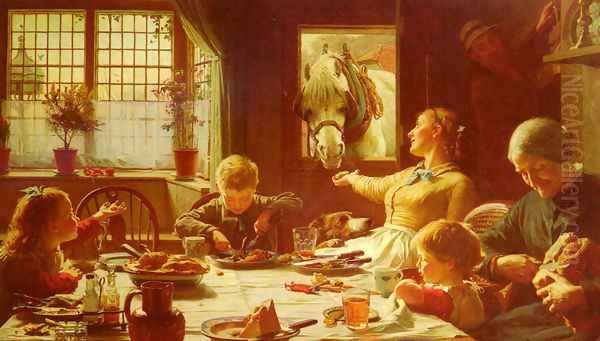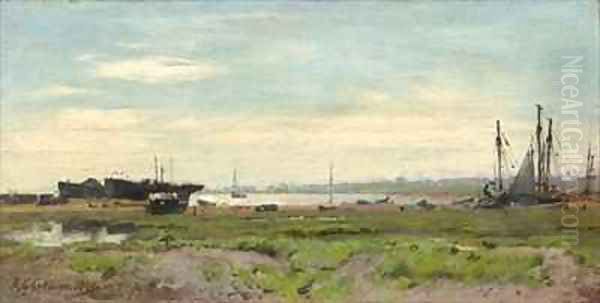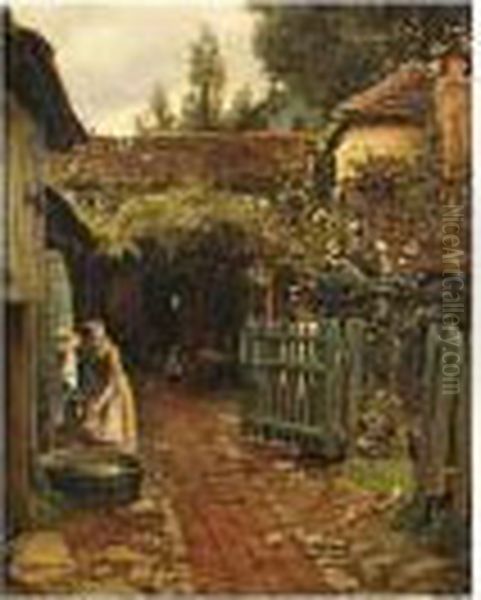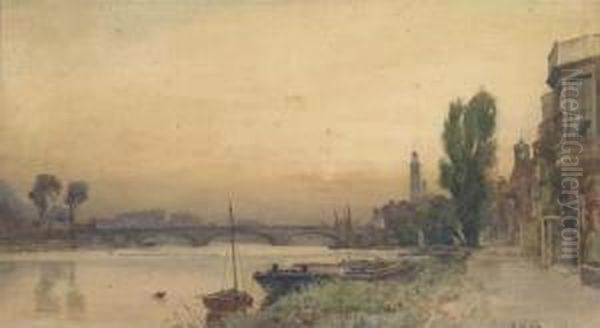Frederick George Cotman (1850-1920) stands as a significant, if sometimes overlooked, figure in the landscape of late Victorian art. An artist whose work bridged the meticulous observation of the Norwich School tradition with the burgeoning narrative tendencies of his era, Cotman carved a niche for himself with his evocative depictions of East Anglian scenery and intimate genre scenes. Nephew of the celebrated watercolourist John Sell Cotman, Frederick George inherited a rich artistic legacy, which he skillfully adapted to his own unique vision, leaving behind a body of work that continues to resonate with its warmth, technical proficiency, and insightful portrayal of rural life.
Early Life and Artistic Inheritance
Born in Ipswich, Suffolk, in 1850, Frederick George Cotman was immersed in an artistic environment from his earliest years. His uncle, John Sell Cotman (1782-1842), was one of the leading figures of the Norwich School of painters, a group renowned for its dedication to depicting the local landscapes of Norfolk and Suffolk. John Sell Cotman was a master of watercolour, known for his bold compositions, innovative use of flat washes, and poetic sensibility. His influence on the development of British watercolour painting was profound, though often not fully appreciated during his lifetime, which was marked by financial struggles despite his immense talent.
The Cotman family was replete with artistic talent. John Sell Cotman's own sons, Miles Edmund Cotman (1810-1858) and John Joseph Cotman (1814-1878), were also accomplished artists, continuing the family tradition of landscape and marine painting. Growing up within this milieu, Frederick George would have been exposed not only to the technical aspects of painting and drawing but also to a deep appreciation for the natural beauty of East Anglia. This early immersion undoubtedly shaped his artistic inclinations and provided a strong foundation for his future career. The legacy of his uncle, in particular, with his emphasis on structural clarity and atmospheric effect, would echo in Frederick George's own mature work.
Formal Training and Emergence

To hone his innate talents, Frederick George Cotman pursued formal artistic training at the prestigious Royal Academy Schools in London. The Royal Academy of Arts, founded by figures like Sir Joshua Reynolds, was the preeminent institution for art education in Britain, and its schools offered rigorous instruction in drawing, painting, and sculpture. Studying here would have exposed Cotman to a wide range of artistic theories, techniques, and the works of both Old Masters and contemporary luminaries. It was a crucible where aspiring artists learned the academic traditions, even if they later chose to diverge from them.
During his time at the Royal Academy Schools, and in the years that followed, Cotman began to exhibit his work, gradually establishing his reputation. He showed paintings at the Royal Academy's annual exhibitions, a crucial venue for artists seeking recognition and patronage. One such early exhibited work was "Departing Ray of Sunshine, Blythburgh," a title that itself evokes the atmospheric qualities that would become a hallmark of his Suffolk landscapes. These exhibitions were vital for an artist's career, providing visibility to critics, collectors, and the public alike, in an era before the proliferation of commercial galleries as we know them today. His contemporaries exhibiting at the RA would have included giants of the Victorian art world such as Frederic Leighton, John Everett Millais, and Lawrence Alma-Tadema, creating a vibrant and competitive artistic environment.
The Norwich School's Enduring Influence
While Frederick George Cotman developed his own distinct style, the influence of the Norwich School, and particularly that of his uncle John Sell Cotman and its co-founder John Crome (1768-1821), remained a significant undercurrent in his work. The Norwich School, active in the first half of the 19th century, was the first provincial art movement in Britain to gain national importance. Its members, including George Vincent, James Stark, and John Thirtle, were inspired by the Dutch Golden Age landscape painters like Jacob van Ruisdael and Meindert Hobbema, as well as the direct observation of their local environment.

John Crome, known as "Old Crome," emphasized a robust naturalism and a deep understanding of light and shadow in his oil paintings of the Norfolk countryside. John Sell Cotman, while sharing this love for local scenery, brought a more refined, almost classical sensibility to his compositions, particularly in his watercolours, which were characterized by their elegant drawing and subtle tonal harmonies. Frederick George Cotman absorbed these lessons, particularly the commitment to depicting specific locales with accuracy and feeling. His landscapes of Suffolk, with their careful attention to the quality of light, the texture of the land, and the distinctive architecture, demonstrate this lineage. He maintained a studio in Norwich for a time, further cementing his connection to the region and its artistic traditions.
Artistic Style and Thematic Concerns
Frederick George Cotman's artistic style can be broadly characterized as Realism, though imbued with a distinct sensitivity to atmosphere and narrative. He worked proficiently in both oils and watercolours, demonstrating a versatile command of different media. His landscapes often capture the tranquil beauty of East Anglia, with its wide skies, meandering rivers, and picturesque villages. He had a keen eye for the nuances of seasonal change and the effects of weather, often employing rich, yet naturalistic, colour palettes and a sophisticated handling of light and shadow to create a sense of depth and mood.
A recurring theme in his work is the interplay between humanity and nature. His paintings frequently include figures engaged in rural labour or quiet contemplation within the landscape, suggesting a harmonious relationship with their surroundings. This is evident in works like "Working in the Field," which depicts agricultural life with an unsentimental yet appreciative eye. His ability to capture the specific character of a place, such as the coastal views in "Runswick Bay" with its striking colour contrasts between sea and land, or the ethereal quality of "Morning Mist," showcases his mastery of landscape painting.
Beyond pure landscape, Cotman was also a skilled genre painter, depicting scenes of everyday life with warmth and insight. These works often focus on domestic interiors or village interactions, revealing his interest in human relationships and social customs. His figures are typically rendered with a sympathetic naturalism, avoiding caricature or overt sentimentality, yet conveying a strong sense of character and emotion.
"One of the Family": A Victorian Masterpiece
Perhaps Frederick George Cotman's most famous and beloved work is the oil painting "One of the Family," completed in 1880. This iconic genre scene depicts a rustic interior where a family is gathered around a table for a meal. A young girl offers a morsel of food to a patient white horse, whose head and neck gently intrude into the domestic space through an open doorway or window. A loyal dog sits expectantly by the table, further emphasizing the theme of animals as integral members of the household.

"One of the Family" is a masterful composition, skillfully balancing the figures and creating a sense of intimate domesticity. The lighting is particularly effective, with a warm glow illuminating the central group and highlighting the textures of wood, fabric, and food. The painting speaks volumes about Victorian attitudes towards family, rural life, and the human-animal bond. It captures a sense of simple, wholesome values, and the inclusion of the horse, a working animal, within the family circle is a particularly charming and telling detail. It reflects a period where animals, especially those essential to rural livelihoods, were often regarded with deep affection and considered part of the extended family unit.
The painting's enduring popularity lies in its universal appeal – the depiction of familial affection, the gentle interaction between child and animal, and the overall sense of peace and contentment. It aligns with a broader trend in Victorian art for narrative genre scenes that resonated with the middle-class public's interest in domesticity and moral values. Artists like William Powell Frith, with his panoramic scenes of Victorian life such as "Derby Day" or "The Railway Station," and Luke Fildes, whose works often carried a strong social message, were immensely popular for their storytelling abilities. While Cotman's "One of the Family" is more intimate in scale and sentiment, it shares this Victorian fascination with narrative and the depiction of contemporary life. The painting has been widely reproduced and remains a quintessential image of Victorian rural charm.
Other Notable Works: Landscapes and Narratives
Beyond "One of the Family," Cotman produced a significant body of work that further illustrates his artistic range and skill. His landscape "Slaughden, on the River Alde," painted in 1899, is a fine example of his ability to capture the specific atmosphere of the Suffolk coast. The painting depicts the riverbank near Aldeburgh, with the North Sea visible in the distance, conveying the expansive, windswept character of this region. His treatment of the water, sky, and marshy foreground demonstrates his keen observational skills and his ability to translate the sensory experience of the landscape onto canvas.
His watercolour "Morning Mist" showcases his talent in this medium, capturing the delicate, diffused light and subtle tonal gradations of a misty morning. This work, with its atmospheric depth, harks back to the poetic sensibilities of his uncle, John Sell Cotman, and demonstrates Frederick George's own mastery of creating mood through light and colour. Similarly, "Departing Ray of Sunshine, Blythburgh," exhibited at the Royal Academy, suggests a focus on transient effects of light, a preoccupation for many landscape painters of the 19th century, from John Constable to the Impressionists.

The painting "Greta Bridge," a subject also famously painted by his uncle John Sell Cotman, indicates an engagement with the picturesque tradition and perhaps a direct homage to his family's artistic lineage. The sale of this work for a modest sum in the 19th century highlights the often-precarious financial realities for many artists of the period, even those with considerable talent. These works, alongside numerous other depictions of Suffolk and Norfolk landscapes, villages, and coastal scenes, solidify Cotman's reputation as a significant chronicler of East Anglia.
Frederick George Cotman as an Educator
Like his uncle John Sell Cotman, who served as Drawing Master at King's College School in London from 1834 until his death, Frederick George Cotman also engaged in teaching. He held the position of Professor of Landscape Painting at King's College, London. This role would have provided a steady income and an opportunity to impart his knowledge and skills to a new generation of artists. Teaching was a common way for artists to supplement their earnings from sales of their work, and it also allowed them to articulate and refine their own artistic principles.
His experience as an educator would have required him to be well-versed in the theory and practice of landscape painting, and to guide students in developing their observational skills and technical proficiency. His connection to King's College thus represents a continuation of the Cotman family's contribution to art education in London, a legacy initiated by his esteemed uncle. This teaching role also placed him within the academic art establishment of the capital, even as his heart and much of his subject matter remained rooted in rural East Anglia.
Relationships with Contemporaries and the Broader Art World
Frederick George Cotman operated within a vibrant and evolving art world. As a member of the later generation associated with the Norwich School, he would have been aware of the legacy of its founders, John Crome and his uncle John Sell Cotman, and contemporaries like George Vincent and James Stark. His work can be seen as extending their principles into the late Victorian era.
He also collaborated with figures like Dawson Turner, a prominent antiquarian and patron of the arts who had been a significant supporter of John Sell Cotman. Frederick George provided illustrations for Turner's architectural etchings, a practice common among artists requiring detailed draughtsmanship and an understanding of architectural form. This collaboration highlights the interdisciplinary connections within the intellectual and artistic circles of the time.

While Cotman's style was largely rooted in Realism, he would have been aware of the diverse artistic currents of the late 19th century. The Pre-Raphaelite Brotherhood, with artists like John Everett Millais, Dante Gabriel Rossetti, and William Holman Hunt, had earlier challenged Academic conventions with their emphasis on truth to nature and detailed symbolism. Later in the century, the influence of French Impressionism, championed by artists like Claude Monet and Camille Pissarro, began to be felt in Britain, with its emphasis on capturing fleeting moments of light and colour through broken brushwork. While Cotman did not fully embrace these more radical movements, his sensitivity to atmospheric effects and light shows an awareness of contemporary concerns in landscape painting.
His relationship with institutions like the Royal Academy was typical for an artist of his standing. Exhibiting there was crucial, but success was not always guaranteed. The user-provided information mentions an unsuccessful early attempt to join the Royal Watercolour Society, which, if accurate for Frederick George Cotman (and not confused with his uncle's experiences), would indicate the competitive nature of the London art scene and the specific criteria of such societies. He also faced comparisons, such as with Francis Towne, an earlier watercolourist whose structural designs bore some resemblance to the Cotmanesque approach, though their overall styles and reception differed.
Later Life, Death, and Legacy
Frederick George Cotman continued to paint throughout his life, remaining dedicated to his chosen themes of East Anglian landscapes and genre scenes. He passed away in 1920, leaving behind a substantial body of work that captures a particular vision of Victorian and Edwardian rural England.
While he may not have achieved the same level of fame as some of his more revolutionary contemporaries or the posthumous critical acclaim afforded to his uncle John Sell Cotman, Frederick George Cotman's contributions are nonetheless significant. His work is valued for its technical skill, its honest and affectionate portrayal of rural life, and its beautiful rendering of the English landscape. Paintings like "One of the Family" have secured his place in popular affection, becoming iconic images of a bygone era.
His influence can be seen in his continuation of the Norwich School's observational tradition and his commitment to watercolour as a serious medium for finished works. His use of flat washes and his ability to create a strong sense of place and atmosphere connect him to the best traditions of British landscape painting. Art historians and collectors today appreciate his work for its intrinsic quality and as an important link in the chain of East Anglian art. His paintings are held in various public and private collections, ensuring that his vision continues to be seen and appreciated.
Conclusion: An Enduring Vision
Frederick George Cotman was an artist of considerable talent and quiet dedication. He successfully navigated the artistic currents of his time, drawing upon the rich legacy of his family and the Norwich School while developing a personal style that resonated with Victorian sensibilities. His landscapes are imbued with a deep love for the East Anglian countryside, capturing its unique light, atmosphere, and character with skill and sensitivity. His genre scenes, particularly the celebrated "One of the Family," offer warm and insightful glimpses into the domestic life and values of his era.
Though perhaps overshadowed at times by his famous uncle or by more avant-garde movements, Frederick George Cotman's work possesses an enduring appeal. He was a skilled draughtsman, a sensitive colourist, and a thoughtful observer of the world around him. His paintings offer a window into late 19th and early 20th century Britain, rendered with an honesty and charm that continue to captivate viewers. As an artist who successfully blended tradition with a personal vision, and as a chronicler of the landscapes and life of his beloved East Anglia, Frederick George Cotman holds a respected place in the annals of British art. His legacy is one of technical proficiency, heartfelt depiction, and a quiet celebration of the enduring beauty of the everyday.